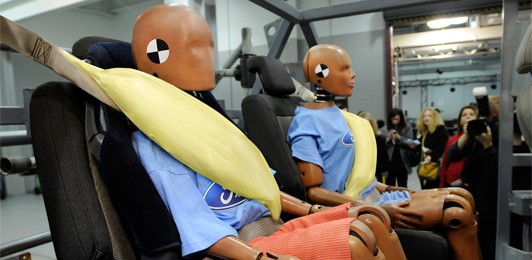Occupant Protection Technologies
Many factors influence a vehicle’s crash performance, including the design of the vehicle’s structure (i.e., its ability to absorb impact energy) and the use of passive safety equipment such as air bags to supplement safety belts. Ford’s commitment to advancing the state-of-the-art in vehicle safety includes research on and development of technologies that further enhance occupant protection in a wide variety of crash circumstances.
Safety belts remain the most important vehicle safety technology available. For the 2011 model year, Ford brought to market the world’s first automotive inflatable safety belts – a brand-new technology that has won several prestigious awards. Specifically, it won Gold in the 2011 Edison Award’s Applied Technology category, Popular Mechanics’ “Breakthrough Award,” Popular Science’s “Best of What’s New” award and the Automobile Journalists Association of Canada’s “Best New Technology” award. The inflatable safety belts combine the attributes of traditional safety belt and air bag technologies to help reduce the risk of head, neck and chest injuries for rear-seat passengers.

Inflatable safety belt technology
Inflatable belts are designed to deploy over a vehicle occupant’s torso and shoulder in less than 40 milliseconds in the event of a crash. Each belt’s tubular air bag inflates with cold compressed gas. The inflatable belt distributes crash force energy across the occupant’s torso, helping to further reduce the risk of injury. In everyday use, the inflatable belts operate like conventional safety belts and are safe and compatible with infant and child safety car and booster seats. In Ford’s research, more than 90 percent of those who tested the inflatable safety belts found them to be similar to, or more comfortable than, a conventional belt.
Ford introduced rear-seat inflatable safety belts on the 2011 Ford Explorer in North America; their availability was expanded to the Ford Flex and Lincoln MKT in early 2012, and will be expanded to the Lincoln MKZ in mid 2012. Plans are also in place to implement rear-seat inflatable belts in other markets.
As part of our continuing effort to enhance the safety and fuel efficiency of our vehicles, Ford is using more ultra-high-strength steels than ever, as well as researching other advanced materials. Increased use of these materials helps us design vehicle structures with enhanced crash energy management, while balancing overall vehicle weight – even as we add more features, equipment and safety devices. As an example, the body structure of the new 2012 Ford Focus is constructed of 55 percent high-strength materials.
